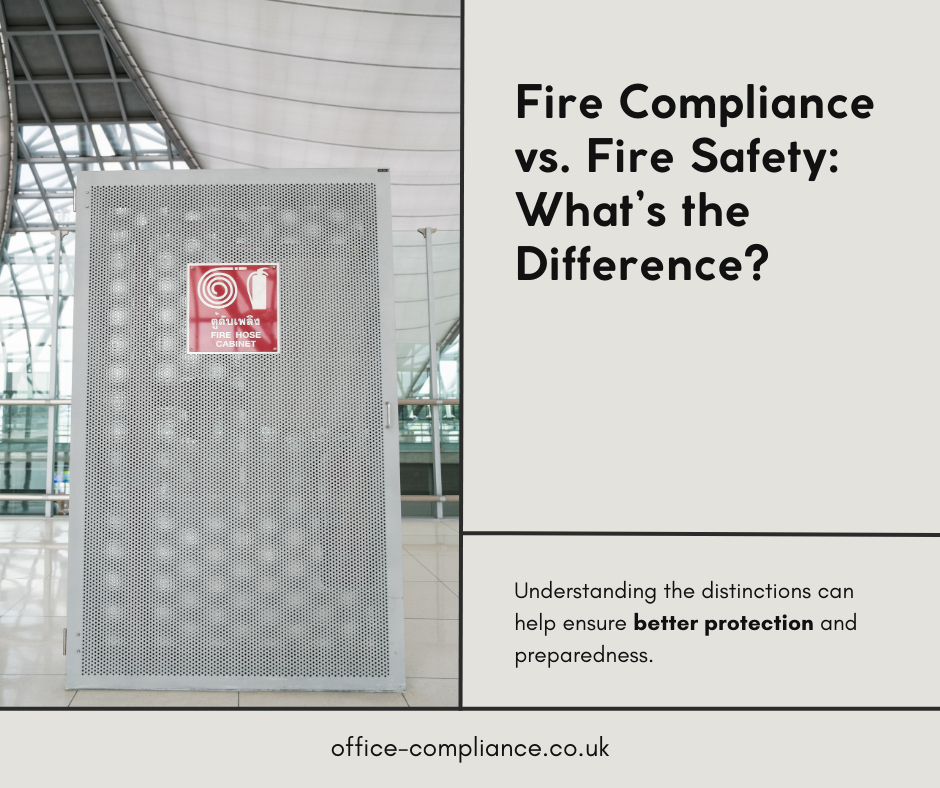
Fire safety is a critical aspect of any building, workplace, or public space. However, many people confuse the terms fire compliance and fire safety, assuming they mean the same thing. While they are closely related, there are important distinctions between them. Understanding these differences is essential for businesses, property owners, and individuals to ensure they meet legal requirements while also creating a genuinely safe environment. This article explores the key differences between fire compliance and fire safety, why both are necessary, and how to implement effective fire safety measures beyond just compliance.
Understanding Fire Compliance
Fire compliance refers to adhering to legal regulations and standards set by government bodies, fire authorities, and industry organisations. These regulations vary by country and region but are designed to ensure that buildings, businesses, and workplaces meet minimum fire safety requirements.
Key Aspects of Fire Compliance:
- Fire Risk Assessments – Conducting thorough risk assessments to identify hazards and implement necessary fire safety measures.
- Building Regulations – Ensuring that structures meet fire-resistant standards, including fire doors, escape routes, and fire-rated materials.
- Fire Equipment Standards – Installing fire alarms, extinguishers, sprinkler systems, and emergency lighting according to legal requirements.
- Employee Training & Drills – Ensuring staff receive appropriate fire safety training and conduct regular evacuation drills.
- Fire Certificates & Documentation – Maintaining records of compliance with fire safety laws, including inspections and maintenance reports.
Legal Requirements for Fire Compliance in the UK
In the UK, fire compliance is governed primarily by the Regulatory Reform (Fire Safety) Order 2005. This legislation places responsibility on business owners, landlords, and employers (referred to as the “responsible person”) to carry out fire risk assessments and implement necessary safety measures. Failure to comply with fire safety laws can result in heavy fines, legal action, and even imprisonment in severe cases.
Understanding Fire Safety
While fire compliance focuses on meeting legal standards, fire safety is a broader concept that aims to prevent fires, reduce risks, and protect lives beyond what is legally required. Fire safety is about best practices, proactive measures, and a safety-first mindset.
Key Aspects of Fire Safety:
- Preventative Measures – Identifying and eliminating potential fire hazards, such as overloaded electrical outlets or improper storage of flammable materials.
- Employee Awareness – Educating employees and occupants on how to prevent fires and respond effectively in an emergency.
- Regular Maintenance & Inspections – Proactively checking fire alarms, extinguishers, and emergency exits beyond the minimum legal requirements.
- Evacuation Planning – Developing and practising fire escape plans, ensuring all occupants are aware of the safest exit routes.
- Safe Work Practices – Encouraging good habits such as keeping exits clear, not blocking fire alarms, and properly using fire-related equipment.
Fire Safety Beyond Compliance
Many businesses and property owners meet fire compliance standards but fail to implement a true fire safety culture. For example, having fire extinguishers is a compliance requirement, but training staff on how to use them ensures fire safety. Similarly, meeting minimum building regulations might ensure legal compliance, but conducting additional fire drills and hazard assessments strengthens fire safety.
Key Differences Between Fire Compliance and Fire Safety
Aspect
Fire Compliance
Fire Safety
Definition
Meeting legal fire safety requirements.
Proactively creating a safer environment.
Focus
Laws, regulations, and codes.
Prevention, training, and best practices.
Responsibility
Business owners, landlords, employers.
Everyone in the organisation or property.
Examples
Fire alarms installed as per legal codes.
Fire alarms tested more frequently than required.
Outcome
Avoid fines and legal penalties.
Reduce fire risks and protect lives.
Why Both Fire Compliance and Fire Safety Matter
It is not enough to simply comply with the law; businesses and property owners must also focus on real fire safety. Here’s why:
- Legal Protection: Compliance ensures you meet legal obligations, reducing the risk of fines and lawsuits.
- Life Protection: Fire safety measures save lives by reducing fire risks and improving emergency response.
- Business Continuity: A well-prepared organisation can prevent fire incidents that could disrupt operations.
- Reputation & Responsibility: Companies that prioritise fire safety demonstrate corporate responsibility and protect employees, customers, and visitors.
How to Improve Fire Safety While Staying Compliant
- Go Beyond Minimum Legal Requirements – Follow best practices such as monthly fire drills and advanced fire detection systems.
- Regular Fire Risk Assessments – Assess fire risks more frequently than legally required to address any potential new hazards.
- Encourage a Fire Safety Culture – Train employees to take fire risks seriously and report hazards immediately.
- Invest in Advanced Fire Protection – Consider fire suppression systems, heat detectors, and smart alarm systems beyond what regulations require.
- Review and Update Fire Safety Plans – Regularly update fire safety procedures and emergency response strategies.
Final Thoughts
While fire compliance ensures that businesses and properties meet legal fire safety requirements, fire safety goes beyond compliance to actively protect lives and prevent disasters. Both are crucial, but real fire protection comes from proactive safety measures, proper training, and a strong fire safety culture. By understanding and implementing both fire compliance and fire safety, organisations and individuals can create a truly safe environment for everyone.

